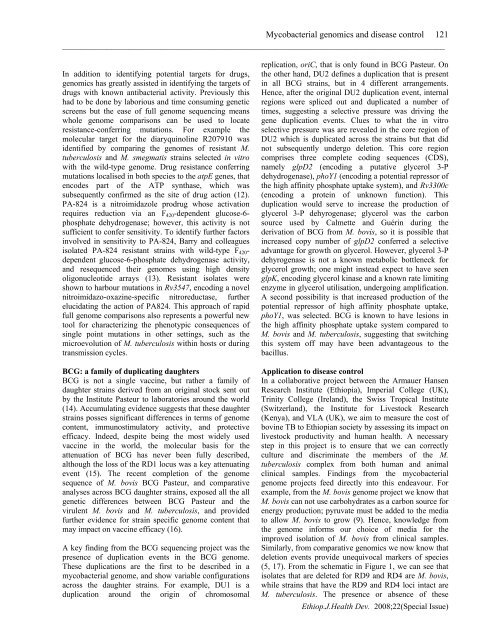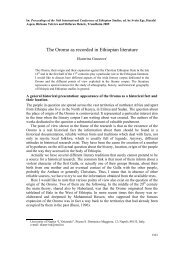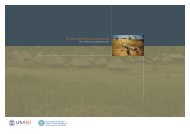You also want an ePaper? Increase the reach of your titles
YUMPU automatically turns print PDFs into web optimized ePapers that Google loves.
Mycobacterial genomics and disease control 121<br />
______________________________________________________________________________________<br />
In addition to identifying potential targets for drugs,<br />
genomics has greatly assisted in identifying the targets of<br />
drugs with known antibacterial activity. Previously this<br />
had to be done by laborious and time consuming genetic<br />
screens but the ease of full genome sequencing means<br />
whole genome comparisons can be used to locate<br />
resistance-conferring mutations. For example the<br />
molecular target for the diaryquinoline R207910 was<br />
identified by comparing the genomes of resistant M.<br />
tuberculosis and M. smegmatis strains selected in vitro<br />
with the wild-type genome. Drug resistance conferring<br />
mutations localised in both species to the atpE genes, that<br />
encodes part of the ATP synthase, which was<br />
subsequently confirmed as the site of drug action (12).<br />
PA-824 is a nitroimidazole prodrug whose activation<br />
requires reduction via an F420-dependent glucose-6phosphate<br />
dehydrogenase; however, this activity is not<br />
sufficient to confer sensitivity. To identify further factors<br />
involved in sensitivity to PA-824, Barry and colleagues<br />
isolated PA-824 resistant strains with wild-type F420dependent<br />
glucose-6-phosphate dehydrogenase activity,<br />
and resequenced their genomes using high density<br />
oligonucleotide arrays (13). Resistant isolates were<br />
shown to harbour mutations in Rv3547, encoding a novel<br />
nitroimidazo-oxazine-specific<br />
nitroreductase, further<br />
elucidating the action of PA824. This approach of rapid<br />
full genome comparisons also represents a powerful new<br />
tool for characterizing the phenotypic consequences of<br />
single point mutations in other settings, such as the<br />
microevolution of M. tuberculosis within hosts or during<br />
transmission cycles.<br />
BCG: a family of duplicating daughters<br />
BCG is not a single vaccine, but rather a family of<br />
daughter strains derived from an original stock sent out<br />
by the Institute Pasteur to laboratories around the world<br />
(14). Accumulating evidence suggests that these daughter<br />
strains posses significant differences in terms of genome<br />
content, immunostimulatory activity, and protective<br />
efficacy. Indeed, despite being the most widely used<br />
vaccine in the world, the molecular basis for the<br />
attenuation of BCG has never been fully described,<br />
although the loss of the RD1 locus was a key attenuating<br />
event (15). The recent completion of the genome<br />
sequence of M. bovis BCG Pasteur, and comparative<br />
analyses across BCG daughter strains, exposed all the all<br />
genetic differences between BCG Pasteur and the<br />
virulent M. bovis and M. tuberculosis, and provided<br />
further evidence for strain specific genome content that<br />
may impact on vaccine efficacy (16).<br />
A key finding from the BCG sequencing project was the<br />
presence of duplication events in the BCG genome.<br />
These duplications are the first to be described in a<br />
mycobacterial genome, and show variable configurations<br />
across the daughter strains. For example, DU1 is a<br />
duplication around the origin of chromosomal<br />
replication, oriC, that is only found in BCG Pasteur. On<br />
the other hand, DU2 defines a duplication that is present<br />
in all BCG strains, but in 4 different arrangements.<br />
Hence, after the original DU2 duplication event, internal<br />
regions were spliced out and duplicated a number of<br />
times, suggesting a selective pressure was driving the<br />
gene duplication events. Clues to what the in vitro<br />
selective pressure was are revealed in the core region of<br />
DU2 which is duplicated across the strains but that did<br />
not subsequently undergo deletion. This core region<br />
comprises three complete coding sequences (CDS),<br />
namely glpD2 (encoding a putative glycerol 3-P<br />
dehydrogenase), phoY1 (encoding a potential repressor of<br />
the high affinity phosphate uptake system), and Rv3300c<br />
(encoding a protein of unknown function). This<br />
duplication would serve to increase the production of<br />
glycerol 3-P dehyrogenase; glycerol was the carbon<br />
source used by Calmette and Guérin during the<br />
derivation of BCG from M. bovis, so it is possible that<br />
increased copy number of glpD2 conferred a selective<br />
advantage for growth on glycerol. However, glycerol 3-P<br />
dehyrogenase is not a known metabolic bottleneck for<br />
glycerol growth; one might instead expect to have seen<br />
glpK, encoding glycerol kinase and a known rate limiting<br />
enzyme in glycerol utilisation, undergoing amplification.<br />
A second possibility is that increased production of the<br />
potential repressor of high affinity phosphate uptake,<br />
phoY1, was selected. BCG is known to have lesions in<br />
the high affinity phosphate uptake system compared to<br />
M. bovis and M. tuberculosis, suggesting that switching<br />
this system off may have been advantageous to the<br />
bacillus.<br />
Application to disease control<br />
In a collaborative project between the Armauer Hansen<br />
Research Institute (Ethiopia), Imperial College (UK),<br />
Trinity College (Ireland), the Swiss Tropical Institute<br />
(Switzerland), the Institute for Livestock Research<br />
(Kenya), and VLA (UK), we aim to measure the cost of<br />
bovine TB to Ethiopian society by assessing its impact on<br />
livestock productivity and human health. A necessary<br />
step in this project is to ensure that we can correctly<br />
culture and discriminate the members of the M.<br />
tuberculosis complex from both human and animal<br />
clinical samples. Findings from the mycobacterial<br />
genome projects feed directly into this endeavour. For<br />
example, from the M. bovis genome project we know that<br />
M. bovis can not use carbohydrates as a carbon source for<br />
energy production; pyruvate must be added to the media<br />
to allow M. bovis to grow (9). Hence, knowledge from<br />
the genome informs our choice of media for the<br />
improved isolation of M. bovis from clinical samples.<br />
Similarly, from comparative genomics we now know that<br />
deletion events provide unequivocal markers of species<br />
(5, 17). From the schematic in Figure 1, we can see that<br />
isolates that are deleted for RD9 and RD4 are M. bovis,<br />
while strains that have the RD9 and RD4 loci intact are<br />
M. tuberculosis. The presence or absence of these<br />
Ethiop.J.Health Dev. <strong>2008</strong>;22(Special Issue)







